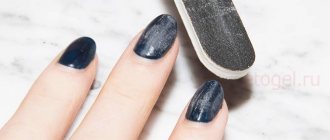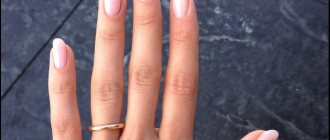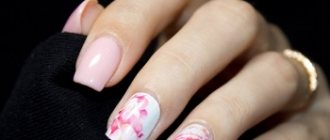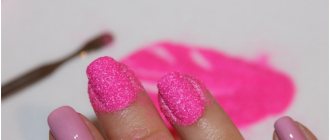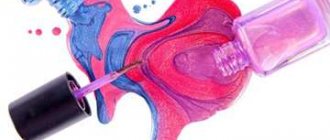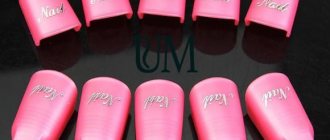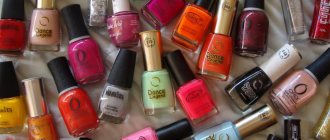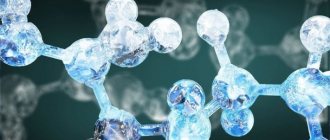What is nail degreaser?
Human skin secretes sweat and oil, which contaminate the nail plate. It is impossible to create a permanent manicure over such stains. To remove this unwanted layer, degreasing agents are used.
A degreaser is a special liquid with a special composition that allows you to remove the oily layer in a short time, as well as disinfect the nail, dry the nail and the skin around it. After this treatment, you can apply regular decorative varnish, extension gel, etc. to the nail.
Neil prep (also called a degreaser) can be used to remove the sticky layer after applying an artificial coating and its polymerization on the nail. Although there is a special liquid for these purposes.
How can you replace a clinser?
If you don’t have a clinser on hand, you can replace it with a product similar in composition. Typically, liquids are used whose main component is alcohol:
- vodka;
- alcohol-based antiseptic;
- alcohol solution (30% alcohol, 70% water);
- boric, formic alcohol.
You can remove the sticky layer after applying the top coat with nail polish remover. But before use, you should look at the composition: if it contains acetone, then the liquid will not work. When removing the sticky layer from the nail plates with acetone or any means based on it, there is a high risk of damage to the coating - it often becomes cloudy, becomes dull, and the gloss disappears.
Compound
When choosing a degreaser, an important element is the composition. The base of the degreaser can be an acid-free substance or an acid-containing one. The difference between these components is colossal - from the cost to the effect on the nail.
In addition to the possible presence of acids (methacrylic acid is used), there may be additional components inside the bottle: vitamin complexes, disinfectants (for example, alcohol, ethyl acetate). Also fragrances, special oils, isobutyl or butyl acetate, isopropanol.
Types of degreasers
Degreasing the nail is a mandatory ritual before covering a natural nail with any material. This can be done either with a single-phase liquid or with others that have additional properties - removing excess moisture from the nail, removing stickiness after polymerization of the gel, etc.
Professional degreasers come in three types, each of which performs its own functions.
Dehydrator
A multifunctional product that replaces many bottles - a dehydrator. The spectrum of its action is so wide that the need to purchase other products simply disappears. But a “proper manicure” involves using the product as one of the stages of nail treatment before covering it with any artificial material. Liquid is needed for the following purposes:
- remove all contaminants from the nail, including sweat and fat deposits (but except for decorative coatings);
- disinfect the surface of the nail;
- dry (that is, dehydrate - deprive the upper layers of the nail of moisture).
Such a product does not violate the pH of the nail plate, and, if necessary, can restore it. In addition to all the above abilities, the dehydrator can be used to remove stickiness after gel coating.
It is recommended to apply the product with a brush, and distribute it evenly over the nail with a special napkin that does not leave any traces (lint, fibers, or other particles). Don’t rush and treat all your nails with a dehydrator at once. By the time the second hand gets to apply the gel (shellac, gel polish), the nails will have time to become dirty more than once. This will not only double the cost of the product, but will also result in wasted time.
Klinser
A beautiful manicure is incomplete without the use of a clinser. It is simply necessary if such compositions are used that, after polymerization, leave stickiness on top of the coating. But this product is not only characterized by the function of removing the sticky layer. It is used as a base for subsequent coating with artificial materials, which results in:
- degreasing marigold;
- elimination of other contaminants;
- antiseptic effect.
Due to the alcohol content, the cleaner can easily be used to treat not only nail plates before coating, but also manicure accessories and a drying lamp.
Essentially, this is a universal liquid that can perform all the necessary functions to create the perfect manicure. But you still shouldn’t give up the dehydrator. It is one of the mandatory stages of nail treatment before coating and nail design.
Primer
A primer is applied for a good connection (grip, adhesion) of the natural nail with almost any artificial coating. It is a “ground base” in the form of a gel-like liquid. Features of the product are:
- preventing the harmful effects of applied materials on the nail;
- removal of any “dirty” deposits;
- dry the nail plate.
Without this product it will be difficult to get a manicure for a long time. The primer opens the scales of the nail plate and settles there tightly.
Subsequent coatings no longer deal with the nail itself, but with a layer of primer; it acts as an “intermediary” between the surfaces. High-quality adhesion when coating gel polish and other materials is ensured not only by using a primer, but also by following all stages of the degreasing and nail preparation procedure.
Professional hairdressers, for example, before the extension procedure, choose a suitable primer for their client. They focus on the expected result and the condition of the nail plate. You can choose an acid-free or acidic primer. They differ from each other precisely by the presence of acid in the composition.
An acid primer-degreaser is more aggressive to both the nail and the skin surrounding it. It can cause damage to your nails if you use the product frequently. Contains methacrylic acid, so apply the primer very carefully to avoid burns.
The product thoroughly dries out all layers of the nail, which has a negative effect on it. Using an acidic agent, you can ensure more reliable adhesion of subsequent layers of coating to the natural nail. Excellent as a base before acrylic extensions.
An acid-free degreaser carefully removes excess fat and other dirt without harming the structure of the nail. After systematic use of this product, your nails will not peel or crumble. It also does not cause irritation, burning, itching, redness of the skin around the nail and other unpleasant sensations. Suitable for use before applying shellac or any gel polish.
How to degrease nails before and after shellac
- Alcohol. As a rule, alcohol or alcohol-containing liquids are found in any home. It is good to use “Ethyl alcohol”. Many girls use eau de toilette or cologne, but they can only remove the sticky layer. Perfumes contain oils, the use of which is prohibited before coating. The same goes for vodka. It also contains volatile compounds that negatively affect the durability of the manicure. The disadvantages of using alcohol include its aggressiveness towards the skin of the fingers and cuticles, as well as the fact that every year it becomes more and more difficult to purchase ethyl alcohol at the pharmacy.
- Boric acid. Boric alcohol, or boric acid, also copes well with the task of degreasing before and after shellac. One of the advantages of the product is its accessibility. Boric acid can be purchased cheaply at any pharmacy.
- Lemon juice. Some women degrease their nails with lemon juice. This is a rather controversial method. After all, natural juice contains essential oils that will promote detachment of the top coating. However, you can wipe your nails with lemon juice after coating. This removes the sticky layer and the surface acquires a glossy shine.
- Soap and water. If there is none of the above in the house, then regular toilet soap can be used. It is necessary to wash your hands thoroughly with soap that does not contain moisturizing additives. It is recommended to use ANTI-GREASE dishwashing detergent. Particular attention is paid to the cuticle and side ridges. After water procedures, it is important to wipe and dry your hands well.
- Nail polish remover. Here you need to pay attention to the composition of the product. If the nail polish remover contains acetone, then it is only suitable for manipulations prior to coating. When a finished manicure is wiped with acetone, the top coat loses its shine and appearance. If the HDSL contains caring components (glycerin or oils), then the effect of the initial degreasing will not be. An oil film on the surface of the nail will negatively affect the coating. Such products can be used at the final stage.
- Professional degreasing products. They have an optimal composition. They cope well with the task assigned to them and at the same time minimize drying of the nail plate and cuticle. As a rule, professional degreasers are universal. They can be used before and after a manicure. They are more expensive than alcohol and boric acid.
How to properly use nail degreaser?
High-quality “dead” adhesion between the nail and the decorative coating is ensured by thorough preparation in several stages. All types of degreasers used must be used correctly, following the following sequence:
- Neil prep (i.e. degreaser) . This is the first step to the perfect manicure. Before use, you need to remove the shine of the nail with a buff. Degrease the surface of the nail with the product. It can be applied directly to the nail and then wiped off with a lint-free cloth. You can soak a napkin with liquid and treat your nails with it.
- Dehydrator . The composition is not always applied. In cases of high sweating on the fingers, you cannot do without it. It is also necessary for the subsequent application of acid-free primer. Acidic does not require treatment of the nail with a dehydrator. The product is applied with a brush, then wiping the nail with a special napkin.
- Primer . Cover the nail with this product very carefully so as not to capture the periungual ridges (regardless of whether it is acidic or not). This should be done with a brush; there is no need to wipe it off.
Next they cover it with bonder (drying it in a lamp), gel polish, gel, etc. Sticky layers are removed with a cleaner.
How to replace degreaser at home?
Experienced nail service professionals prefer only professional manicure products in their work, fearing experiments and unpredictable consequences, so as not to risk their reputation in front of an established client base. But not all lovers of spectacular nails at home can afford them.
You can degrease your nails before coating not only with special liquids. There are many other substances that can replace them.
Boric acid.
Pharmacy alternative to replace standard degreaser. Able to degrease and clean the nail of all contaminants, while simultaneously disinfecting it. But it is not recommended to use the solution often, since the composition contains alcohol, which gradually dries out the nail. Using boric acid is simple: just moisten a cotton sponge or a piece of cotton wool with the liquid, then wipe your nails and the area around it.
Lemon juice.
A popular and proven way to remove fat from nails is lemon juice. If this citrus is not available, then it can be replaced with citric acid, having previously dissolved it (half a teaspoon per 100 g of water). But lemon juice or solution does not effectively degrease the surface of the nail, but is necessary to remove dirt from it. After moistening a cotton wool or sponge in the liquid, wipe the nails thoroughly.
Alcohol.
What is needed is medical alcohol without impurities. Vodka in this case will not be an alternative. Typically, alcohol not only degreases the nail, but also thoroughly disinfects it, preventing the development of fungi and other pathogens. After moistening a cotton pad with alcohol, wipe the surface of the nail. The systematic use of alcohol for degreasing is not recommended, as it greatly depletes the nail.
Soap.
Using soap for degreasing on a regular basis is not a very good option. Although it can be used to remove fatty deposits and dirt from the nail, it still will not be a reliable means of guaranteeing a long-lasting manicure. Using soap is simple: lather your hands, rinse under running water. If necessary, repeat the procedure.
Nail polish remover.
If the liquid does not contain acetone, then such a product can only partially replace a degreasing product. It ineffectively removes impurities, leaving some of the fatty deposits on the nail surface. To use the product, you need to apply it to a sponge (cotton pad, a small piece of cotton wool) and wipe your nails with it, as when removing nail polish.
How to remove the sticky layer at home
Today, many manufacturers produce liquids to remove the dispersion layer. They are called clinsers. Usually their composition is extremely simple:
- water;
- alcohol;
- fragrances
Some formulations contain oil. If this is the liquid you have, then use it exclusively for the finishing coat. If you rub it between colored layers, the adhesion will become unreliable.
Cleaners are used both when working with gel polishes and when in contact with biogel. Of course, it is best to buy a product from the same company as your varnishes, base and top coat. If you use products from one manufacturer, then you can not expect any extraneous chemical reaction. But if you have products from different manufacturers, then the gel polish may simply become cloudy from contact with an unsuitable product.
Review of popular degreasers
For a good manicure, you don’t have to buy a lot of bottles. Often, nail technicians, to save money, use universal or multifunctional liquids that combine several products. Available in packaging with different amounts of liquid in bottles.
Severina. The Severina degreaser has a relatively low cost, while combining the standard functions of a degreaser and a classic cleaner. Eliminates excess moisture from the surface layers of the nail.
Orly. The 3 in 1 Gel FX Cleanser combines three necessary products that need to be used to treat the nail before and during a manicure: a degreaser, a dehydrating dehydrator, and a dispersion-removing clinser.
Canni . A harmonious tandem of degreaser and dehydrator in one bottle. Professionally prepares the nail plate for any nail modeling system.
My Nail. Prep Nail combines two professional products – a dehydrator and a degreaser. Recommended for use before gel extensions or gel polish coating.
Kodi . Cody's Nail fresher product thoroughly degreases, removes excess moisture, disinfects, and acts as an acid-free primer. Suitable for use before coating with any material.
You probably don't know:
- How to use acrylic powder to strengthen nails?
- Acrylic on your own nails
- Nail correction with gel at home for beginners step by step

